Detailed Comparative Analysis of Hypertension Guidelines (Healthcare)
VerifiedAdded on 2021/04/21
|12
|1488
|95
Report
AI Summary
This report provides a comparative analysis of various hypertension guidelines, including those from the American College of Cardiology/American Heart Association, the European Society of Hypertension and Cardiology, and JNC 8. It examines the categorization of blood pressure, risk factors, measurement methodologies, and pharmacological interventions. The report also explores the impact of the SPRINT trial, highlighting its pros and cons, and discusses challenges in treating hypertension in the elderly, including measurement difficulties, controversies in new blood pressure categories, and the risks associated with treatment, such as cognitive decline and drug interactions. The analysis encompasses the effects of different medications, statistical data, and specific considerations for handling patients with co-morbidities and women during pregnancy. The report aims to provide a comprehensive overview of the current landscape of hypertension management and its implications.
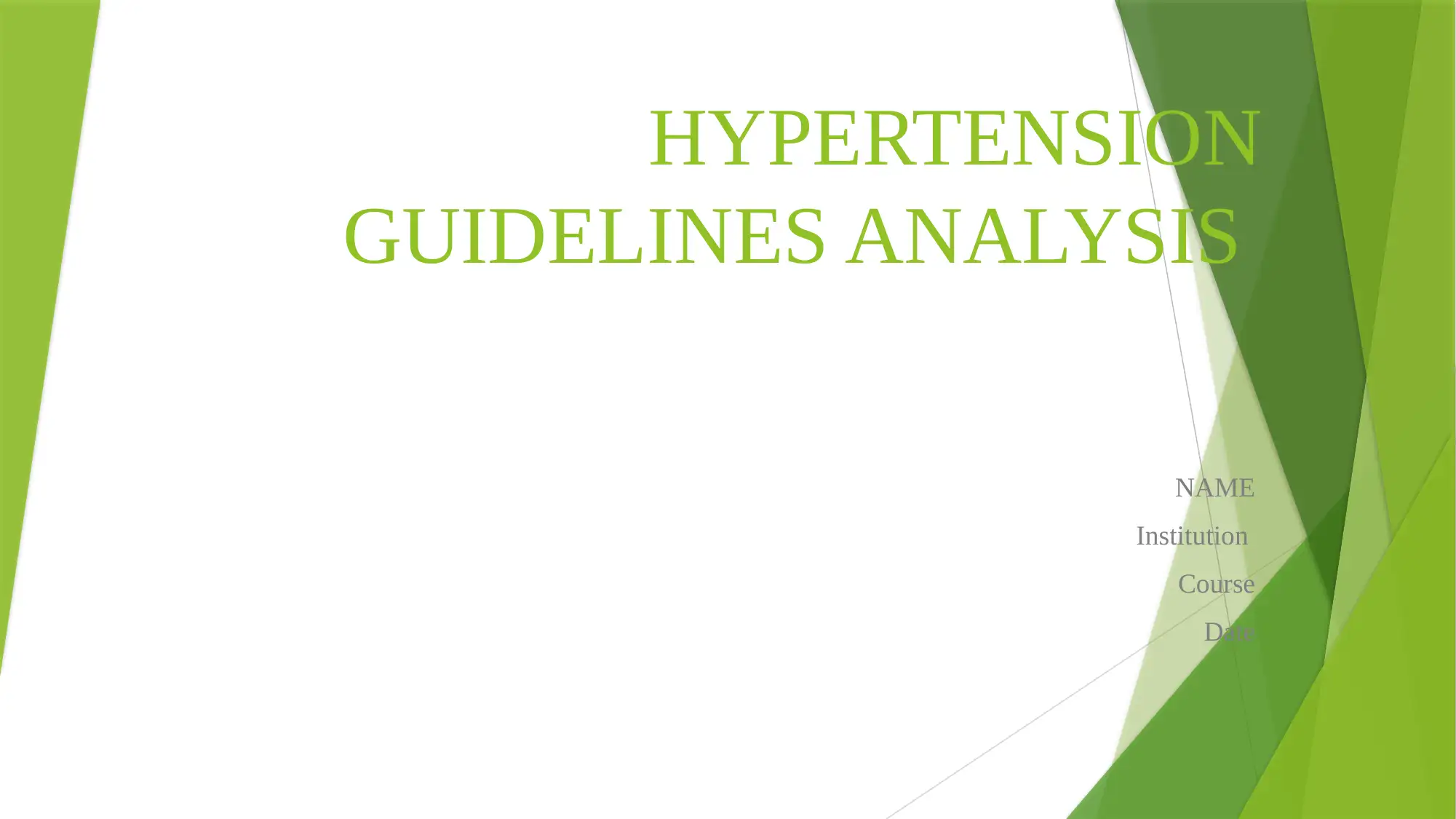
HYPERTENSION
GUIDELINES ANALYSIS
NAME
Institution
Course
Date
GUIDELINES ANALYSIS
NAME
Institution
Course
Date
Paraphrase This Document
Need a fresh take? Get an instant paraphrase of this document with our AI Paraphraser
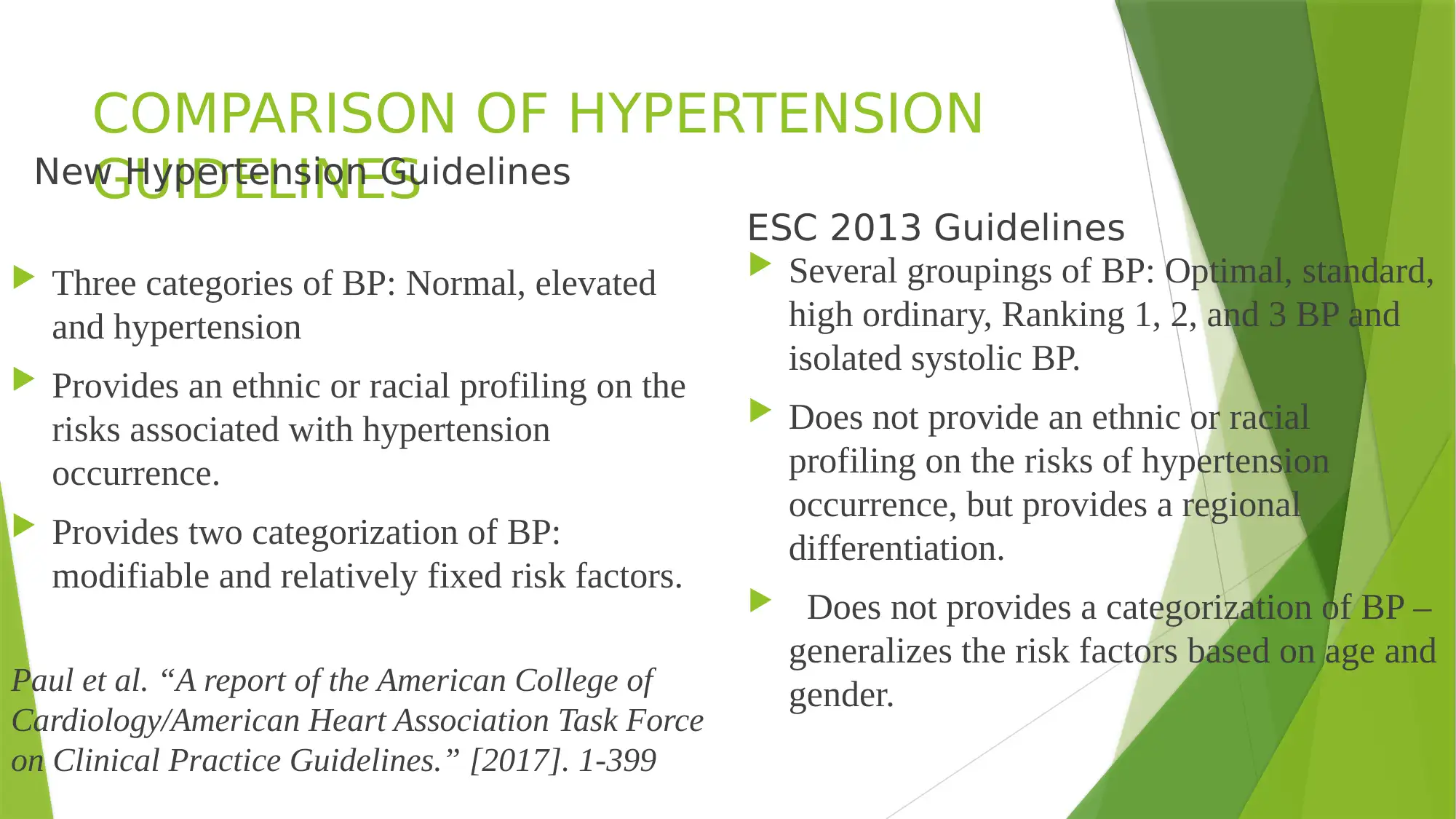
COMPARISON OF HYPERTENSION
GUIDELINESNew Hypertension Guidelines
Three categories of BP: Normal, elevated
and hypertension
Provides an ethnic or racial profiling on the
risks associated with hypertension
occurrence.
Provides two categorization of BP:
modifiable and relatively fixed risk factors.
Paul et al. “A report of the American College of
Cardiology/American Heart Association Task Force
on Clinical Practice Guidelines.” [2017]. 1-399
ESC 2013 Guidelines
Several groupings of BP: Optimal, standard,
high ordinary, Ranking 1, 2, and 3 BP and
isolated systolic BP.
Does not provide an ethnic or racial
profiling on the risks of hypertension
occurrence, but provides a regional
differentiation.
Does not provides a categorization of BP –
generalizes the risk factors based on age and
gender.
GUIDELINESNew Hypertension Guidelines
Three categories of BP: Normal, elevated
and hypertension
Provides an ethnic or racial profiling on the
risks associated with hypertension
occurrence.
Provides two categorization of BP:
modifiable and relatively fixed risk factors.
Paul et al. “A report of the American College of
Cardiology/American Heart Association Task Force
on Clinical Practice Guidelines.” [2017]. 1-399
ESC 2013 Guidelines
Several groupings of BP: Optimal, standard,
high ordinary, Ranking 1, 2, and 3 BP and
isolated systolic BP.
Does not provide an ethnic or racial
profiling on the risks of hypertension
occurrence, but provides a regional
differentiation.
Does not provides a categorization of BP –
generalizes the risk factors based on age and
gender.

COMPARISON OF HYPERTENSION
GUIDELINESNew Hypertension Guidelines
Offers categorization of occurrence of BP
Provides a guideline on measuring BP based
on environment (out-of-office, ambulance,
home and office)
Presents statistical reference data on
measurement of BP based on day-time and
night-time (systolic and diastolic)
Indicates primary and secondary causes of BP
in adults.
Paul et al. “A report of the American College of
Cardiology/American Heart Association Task Force on
Clinical Practice Guidelines.” [2017]. 1-399
ESC 2013 Guidelines
Provides categorization based on age and gender.
Provides a guideline on measuring BP based on
environment (out-of-office, office, home and
ambulance).
Presents statistical reference data on the
measurement of BP based on day-time and night-
time.
Gives a generalized understanding of BP causes in
adults.
Mancia et al. “The Task Force for the Management of
Arterial Hypertension of the European Society of
Hypertension and of the European Society of
Cardiology.” [2013]. 1-77
GUIDELINESNew Hypertension Guidelines
Offers categorization of occurrence of BP
Provides a guideline on measuring BP based
on environment (out-of-office, ambulance,
home and office)
Presents statistical reference data on
measurement of BP based on day-time and
night-time (systolic and diastolic)
Indicates primary and secondary causes of BP
in adults.
Paul et al. “A report of the American College of
Cardiology/American Heart Association Task Force on
Clinical Practice Guidelines.” [2017]. 1-399
ESC 2013 Guidelines
Provides categorization based on age and gender.
Provides a guideline on measuring BP based on
environment (out-of-office, office, home and
ambulance).
Presents statistical reference data on the
measurement of BP based on day-time and night-
time.
Gives a generalized understanding of BP causes in
adults.
Mancia et al. “The Task Force for the Management of
Arterial Hypertension of the European Society of
Hypertension and of the European Society of
Cardiology.” [2013]. 1-77
⊘ This is a preview!⊘
Do you want full access?
Subscribe today to unlock all pages.

Trusted by 1+ million students worldwide
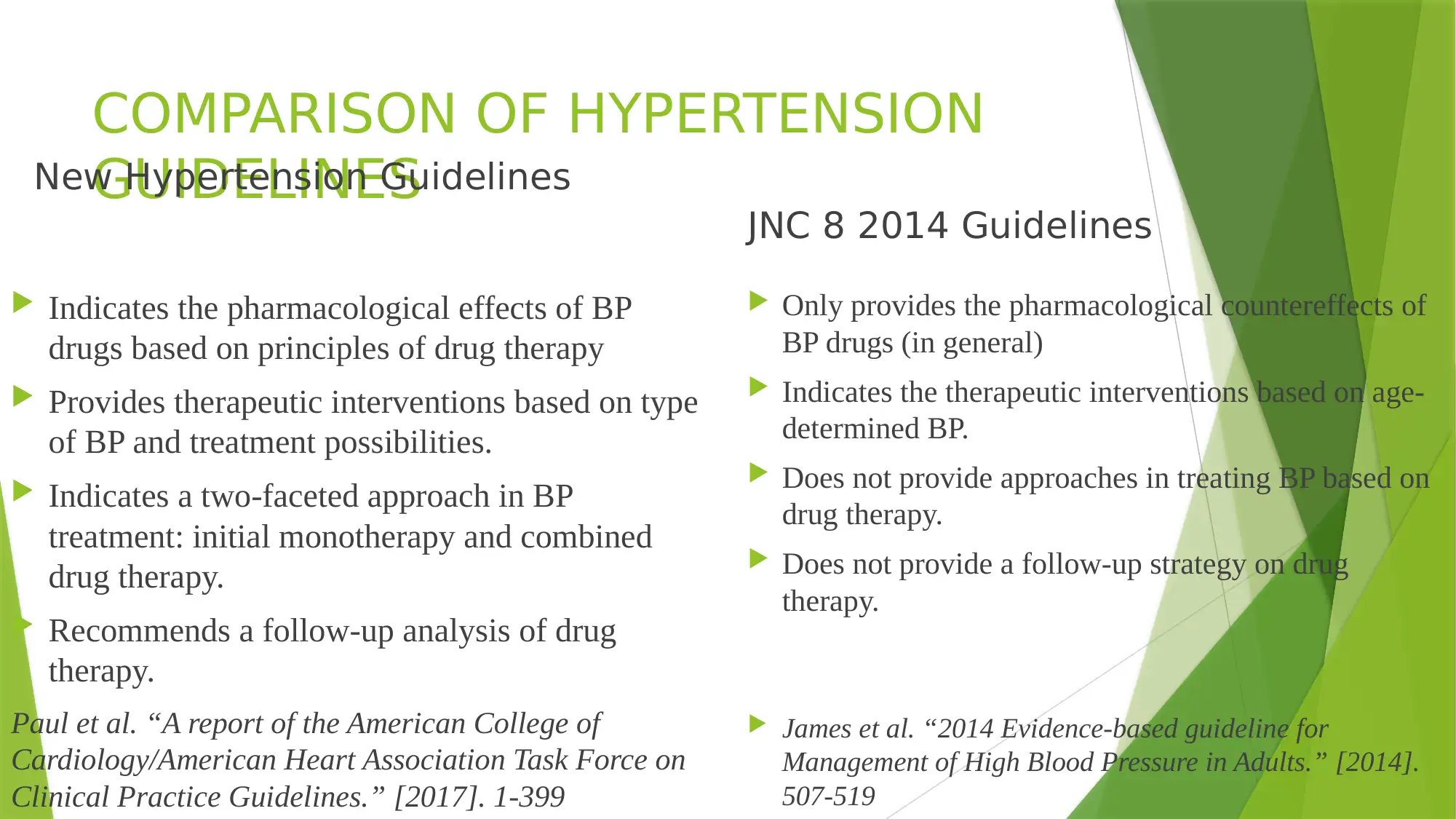
COMPARISON OF HYPERTENSION
GUIDELINESNew Hypertension Guidelines
Indicates the pharmacological effects of BP
drugs based on principles of drug therapy
Provides therapeutic interventions based on type
of BP and treatment possibilities.
Indicates a two-faceted approach in BP
treatment: initial monotherapy and combined
drug therapy.
Recommends a follow-up analysis of drug
therapy.
Paul et al. “A report of the American College of
Cardiology/American Heart Association Task Force on
Clinical Practice Guidelines.” [2017]. 1-399
JNC 8 2014 Guidelines
Only provides the pharmacological countereffects of
BP drugs (in general)
Indicates the therapeutic interventions based on age-
determined BP.
Does not provide approaches in treating BP based on
drug therapy.
Does not provide a follow-up strategy on drug
therapy.
James et al. “2014 Evidence-based guideline for
Management of High Blood Pressure in Adults.” [2014].
507-519
GUIDELINESNew Hypertension Guidelines
Indicates the pharmacological effects of BP
drugs based on principles of drug therapy
Provides therapeutic interventions based on type
of BP and treatment possibilities.
Indicates a two-faceted approach in BP
treatment: initial monotherapy and combined
drug therapy.
Recommends a follow-up analysis of drug
therapy.
Paul et al. “A report of the American College of
Cardiology/American Heart Association Task Force on
Clinical Practice Guidelines.” [2017]. 1-399
JNC 8 2014 Guidelines
Only provides the pharmacological countereffects of
BP drugs (in general)
Indicates the therapeutic interventions based on age-
determined BP.
Does not provide approaches in treating BP based on
drug therapy.
Does not provide a follow-up strategy on drug
therapy.
James et al. “2014 Evidence-based guideline for
Management of High Blood Pressure in Adults.” [2014].
507-519
Paraphrase This Document
Need a fresh take? Get an instant paraphrase of this document with our AI Paraphraser

COMPARISON OF HYPERTENSION
GUIDELINESNew Hypertension Guidelines
Indicates measures to take in handling
adults with different types of heart diseases
such as SIHD- stable ischemic heart disease.
Shows measures to undertake when it comes
to handling patients with complementary
illnesses such as renal defects.
Presents a categorical handling of women
based on pregnancy with an inclusion of
SPRINT test analysis recommendations.
JNC 8 2014 Guidelines
Only indicates the best options in handling patients
based on their ages.
Also indicates the best measures to take when
handling patients with heart complications as well
as other complementary illnesses however, based
on age
Does not provide a list of handling
recommendations when it comes to women and
pregnancy.
James et al. “2014 Evidence-based guideline for
Management of High Blood Pressure in Adults.”
[2014]. 507-519
GUIDELINESNew Hypertension Guidelines
Indicates measures to take in handling
adults with different types of heart diseases
such as SIHD- stable ischemic heart disease.
Shows measures to undertake when it comes
to handling patients with complementary
illnesses such as renal defects.
Presents a categorical handling of women
based on pregnancy with an inclusion of
SPRINT test analysis recommendations.
JNC 8 2014 Guidelines
Only indicates the best options in handling patients
based on their ages.
Also indicates the best measures to take when
handling patients with heart complications as well
as other complementary illnesses however, based
on age
Does not provide a list of handling
recommendations when it comes to women and
pregnancy.
James et al. “2014 Evidence-based guideline for
Management of High Blood Pressure in Adults.”
[2014]. 507-519
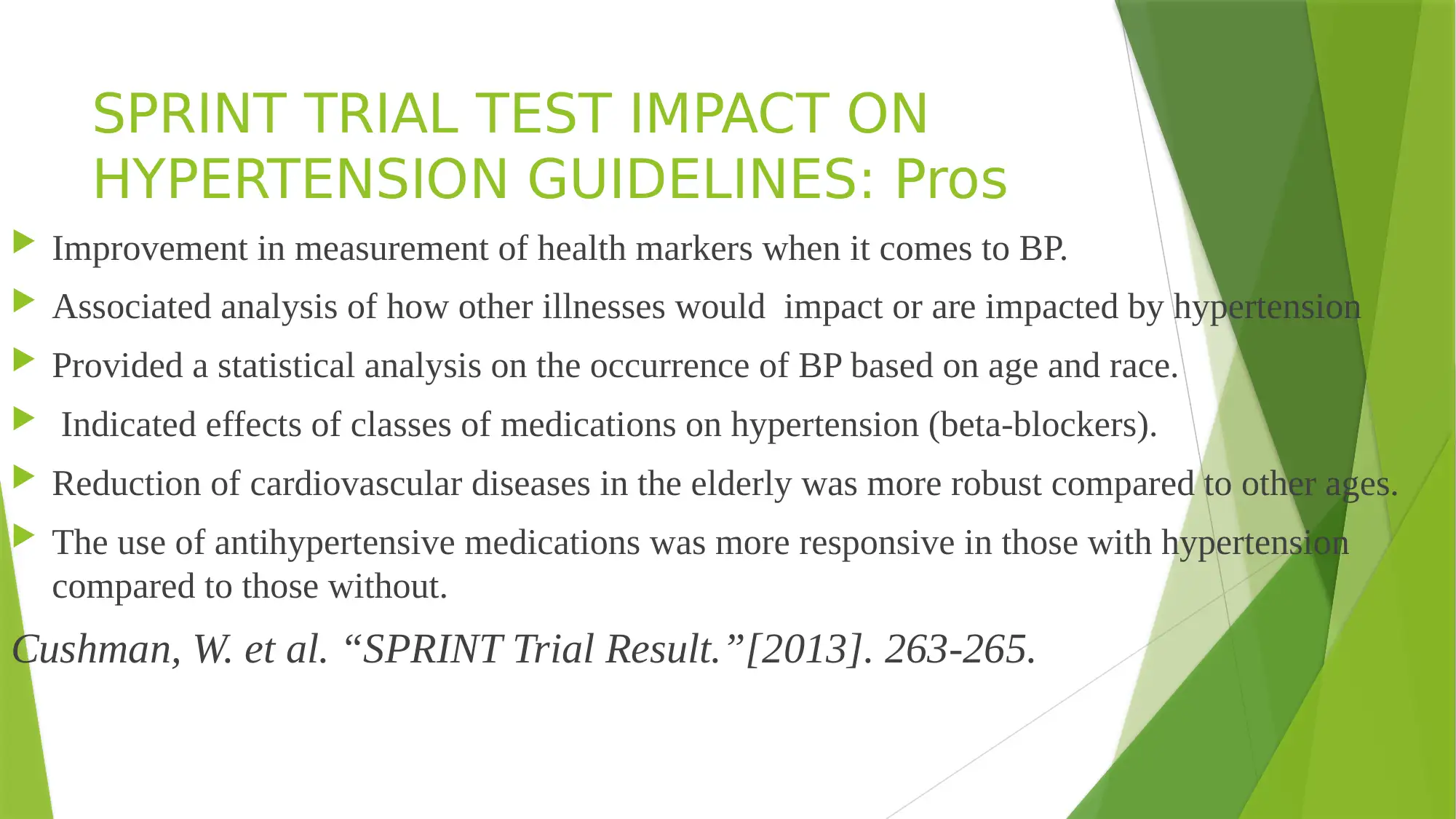
SPRINT TRIAL TEST IMPACT ON
HYPERTENSION GUIDELINES: Pros
Improvement in measurement of health markers when it comes to BP.
Associated analysis of how other illnesses would impact or are impacted by hypertension
Provided a statistical analysis on the occurrence of BP based on age and race.
Indicated effects of classes of medications on hypertension (beta-blockers).
Reduction of cardiovascular diseases in the elderly was more robust compared to other ages.
The use of antihypertensive medications was more responsive in those with hypertension
compared to those without.
Cushman, W. et al. “SPRINT Trial Result.”[2013]. 263-265.
HYPERTENSION GUIDELINES: Pros
Improvement in measurement of health markers when it comes to BP.
Associated analysis of how other illnesses would impact or are impacted by hypertension
Provided a statistical analysis on the occurrence of BP based on age and race.
Indicated effects of classes of medications on hypertension (beta-blockers).
Reduction of cardiovascular diseases in the elderly was more robust compared to other ages.
The use of antihypertensive medications was more responsive in those with hypertension
compared to those without.
Cushman, W. et al. “SPRINT Trial Result.”[2013]. 263-265.
⊘ This is a preview!⊘
Do you want full access?
Subscribe today to unlock all pages.

Trusted by 1+ million students worldwide

SPRINT TRIAL TEST IMPACT ON
HYPERTENSION GUIDELINES: Cons
Proposes that cardiovascular risk is higher.
Change in pre-determined and already accepted universal measurements when it comes to BP
May change the dynamics in drug therapy especially those used in relation with other
illnesses such as renal failure and pregnancy.
Exclusion of individuals with diabetes mellitus limiting the understanding
of how to treat those with diabetes.
Reduced BP levels in SPRINT may have brought no significant benefit on
the risk of either myocardial infarction or stroke
Cushman, W. et al. “SPRINT Trial Result.”[2013]. 263-265.
Bakris, George ad Sorrentino, Matthew. “Redefining hypertension-Assessing the new Blood-pressure Guidelines.”
[2018]. New England Journal of Medicine. 497-501
HYPERTENSION GUIDELINES: Cons
Proposes that cardiovascular risk is higher.
Change in pre-determined and already accepted universal measurements when it comes to BP
May change the dynamics in drug therapy especially those used in relation with other
illnesses such as renal failure and pregnancy.
Exclusion of individuals with diabetes mellitus limiting the understanding
of how to treat those with diabetes.
Reduced BP levels in SPRINT may have brought no significant benefit on
the risk of either myocardial infarction or stroke
Cushman, W. et al. “SPRINT Trial Result.”[2013]. 263-265.
Bakris, George ad Sorrentino, Matthew. “Redefining hypertension-Assessing the new Blood-pressure Guidelines.”
[2018]. New England Journal of Medicine. 497-501
Paraphrase This Document
Need a fresh take? Get an instant paraphrase of this document with our AI Paraphraser
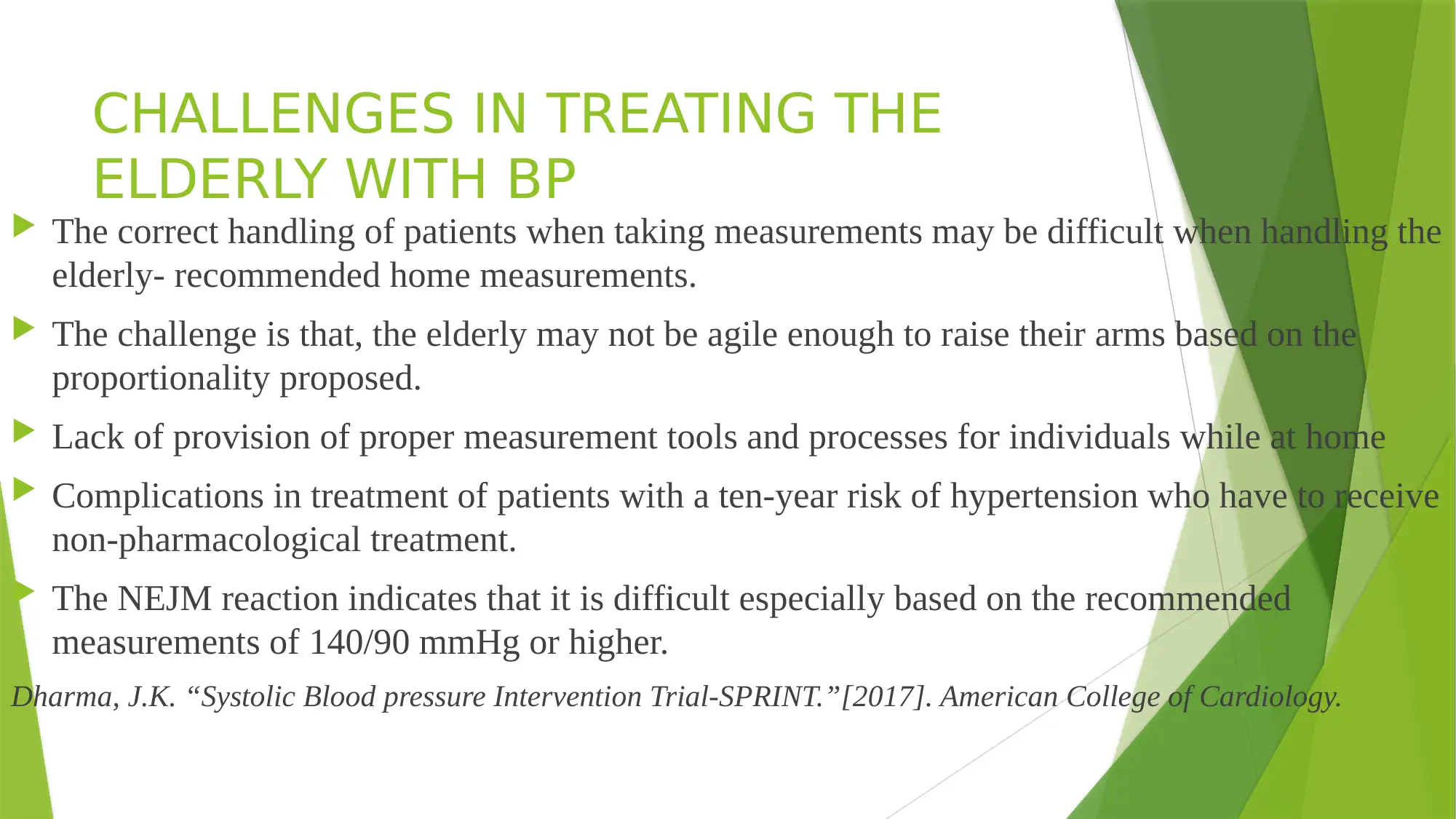
CHALLENGES IN TREATING THE
ELDERLY WITH BP
The correct handling of patients when taking measurements may be difficult when handling the
elderly- recommended home measurements.
The challenge is that, the elderly may not be agile enough to raise their arms based on the
proportionality proposed.
Lack of provision of proper measurement tools and processes for individuals while at home
Complications in treatment of patients with a ten-year risk of hypertension who have to receive
non-pharmacological treatment.
The NEJM reaction indicates that it is difficult especially based on the recommended
measurements of 140/90 mmHg or higher.
Dharma, J.K. “Systolic Blood pressure Intervention Trial-SPRINT.”[2017]. American College of Cardiology.
ELDERLY WITH BP
The correct handling of patients when taking measurements may be difficult when handling the
elderly- recommended home measurements.
The challenge is that, the elderly may not be agile enough to raise their arms based on the
proportionality proposed.
Lack of provision of proper measurement tools and processes for individuals while at home
Complications in treatment of patients with a ten-year risk of hypertension who have to receive
non-pharmacological treatment.
The NEJM reaction indicates that it is difficult especially based on the recommended
measurements of 140/90 mmHg or higher.
Dharma, J.K. “Systolic Blood pressure Intervention Trial-SPRINT.”[2017]. American College of Cardiology.
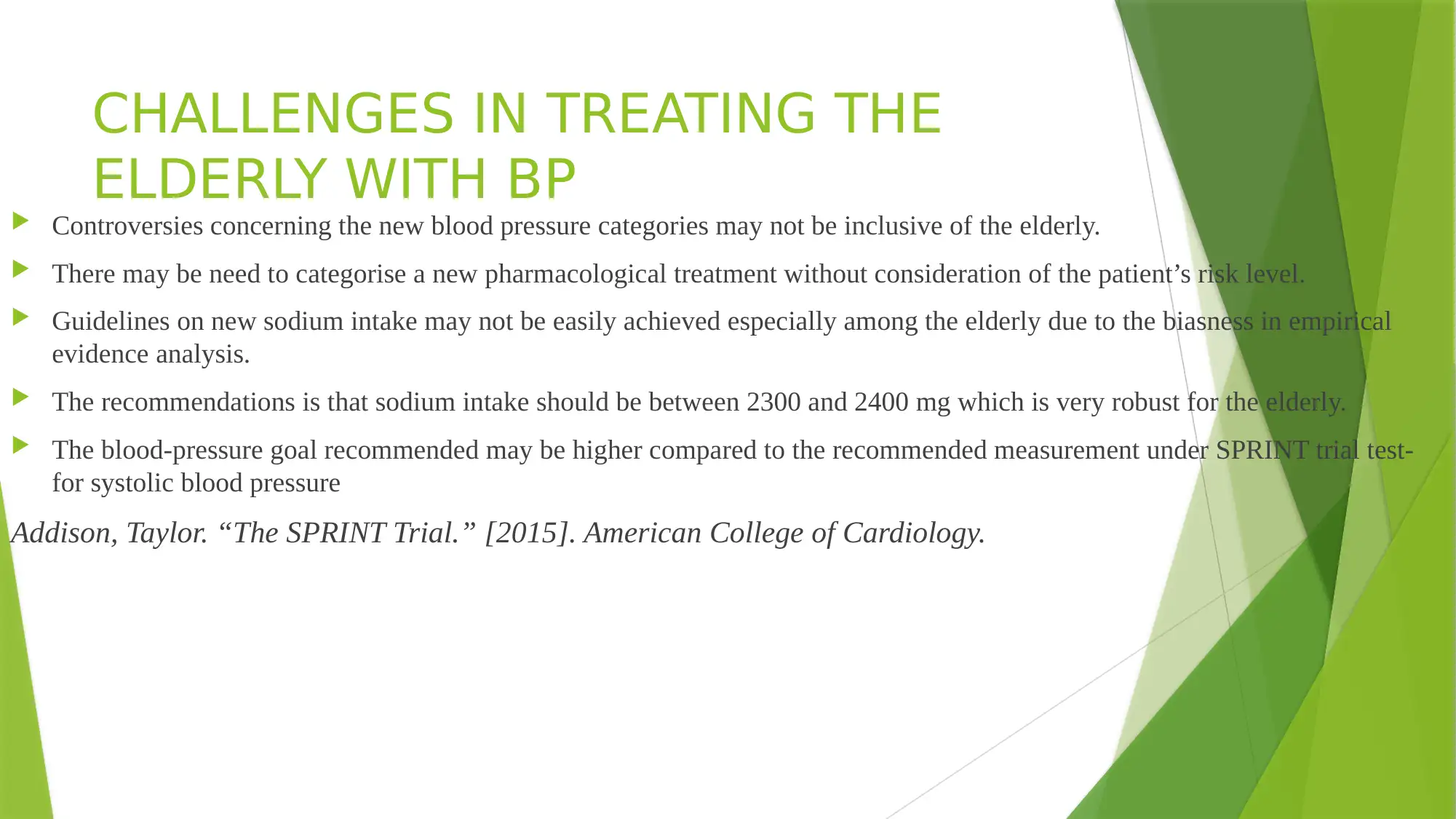
CHALLENGES IN TREATING THE
ELDERLY WITH BP
Controversies concerning the new blood pressure categories may not be inclusive of the elderly.
There may be need to categorise a new pharmacological treatment without consideration of the patient’s risk level.
Guidelines on new sodium intake may not be easily achieved especially among the elderly due to the biasness in empirical
evidence analysis.
The recommendations is that sodium intake should be between 2300 and 2400 mg which is very robust for the elderly.
The blood-pressure goal recommended may be higher compared to the recommended measurement under SPRINT trial test-
for systolic blood pressure
Addison, Taylor. “The SPRINT Trial.” [2015]. American College of Cardiology.
ELDERLY WITH BP
Controversies concerning the new blood pressure categories may not be inclusive of the elderly.
There may be need to categorise a new pharmacological treatment without consideration of the patient’s risk level.
Guidelines on new sodium intake may not be easily achieved especially among the elderly due to the biasness in empirical
evidence analysis.
The recommendations is that sodium intake should be between 2300 and 2400 mg which is very robust for the elderly.
The blood-pressure goal recommended may be higher compared to the recommended measurement under SPRINT trial test-
for systolic blood pressure
Addison, Taylor. “The SPRINT Trial.” [2015]. American College of Cardiology.
⊘ This is a preview!⊘
Do you want full access?
Subscribe today to unlock all pages.

Trusted by 1+ million students worldwide
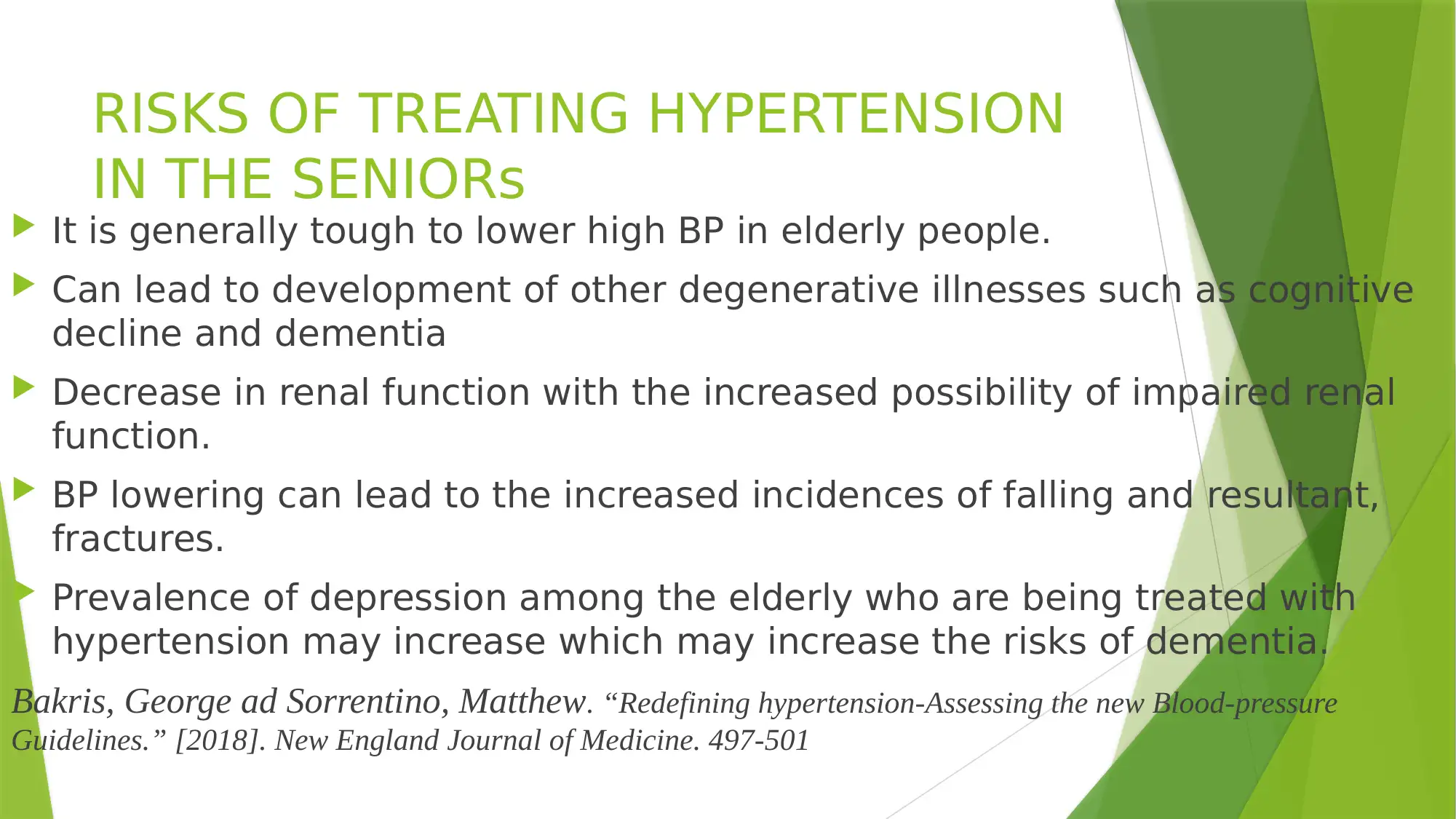
RISKS OF TREATING HYPERTENSION
IN THE SENIORs
It is generally tough to lower high BP in elderly people.
Can lead to development of other degenerative illnesses such as cognitive
decline and dementia
Decrease in renal function with the increased possibility of impaired renal
function.
BP lowering can lead to the increased incidences of falling and resultant,
fractures.
Prevalence of depression among the elderly who are being treated with
hypertension may increase which may increase the risks of dementia.
Bakris, George ad Sorrentino, Matthew. “Redefining hypertension-Assessing the new Blood-pressure
Guidelines.” [2018]. New England Journal of Medicine. 497-501
IN THE SENIORs
It is generally tough to lower high BP in elderly people.
Can lead to development of other degenerative illnesses such as cognitive
decline and dementia
Decrease in renal function with the increased possibility of impaired renal
function.
BP lowering can lead to the increased incidences of falling and resultant,
fractures.
Prevalence of depression among the elderly who are being treated with
hypertension may increase which may increase the risks of dementia.
Bakris, George ad Sorrentino, Matthew. “Redefining hypertension-Assessing the new Blood-pressure
Guidelines.” [2018]. New England Journal of Medicine. 497-501
Paraphrase This Document
Need a fresh take? Get an instant paraphrase of this document with our AI Paraphraser
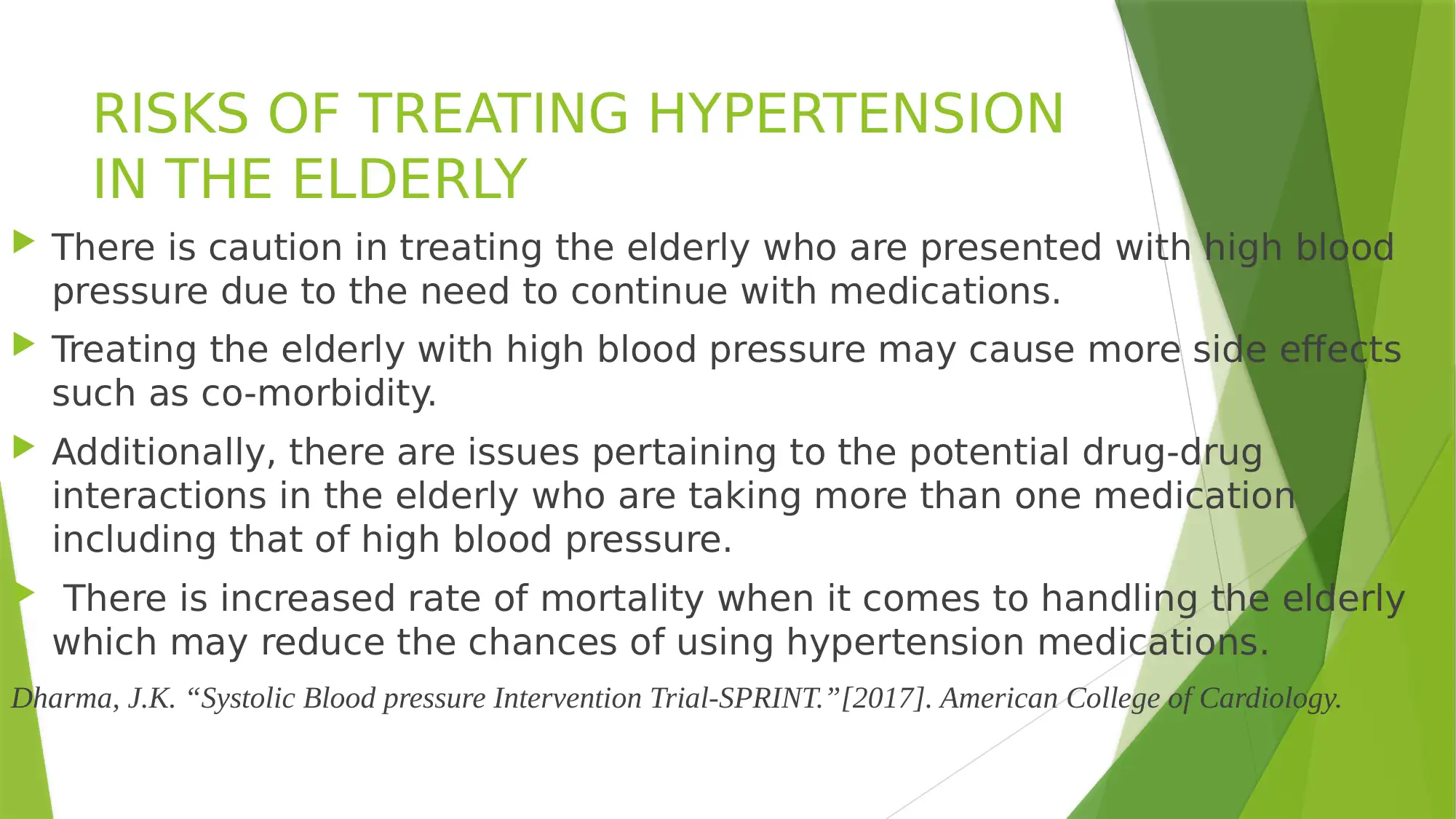
RISKS OF TREATING HYPERTENSION
IN THE ELDERLY
There is caution in treating the elderly who are presented with high blood
pressure due to the need to continue with medications.
Treating the elderly with high blood pressure may cause more side effects
such as co-morbidity.
Additionally, there are issues pertaining to the potential drug-drug
interactions in the elderly who are taking more than one medication
including that of high blood pressure.
There is increased rate of mortality when it comes to handling the elderly
which may reduce the chances of using hypertension medications.
Dharma, J.K. “Systolic Blood pressure Intervention Trial-SPRINT.”[2017]. American College of Cardiology.
IN THE ELDERLY
There is caution in treating the elderly who are presented with high blood
pressure due to the need to continue with medications.
Treating the elderly with high blood pressure may cause more side effects
such as co-morbidity.
Additionally, there are issues pertaining to the potential drug-drug
interactions in the elderly who are taking more than one medication
including that of high blood pressure.
There is increased rate of mortality when it comes to handling the elderly
which may reduce the chances of using hypertension medications.
Dharma, J.K. “Systolic Blood pressure Intervention Trial-SPRINT.”[2017]. American College of Cardiology.
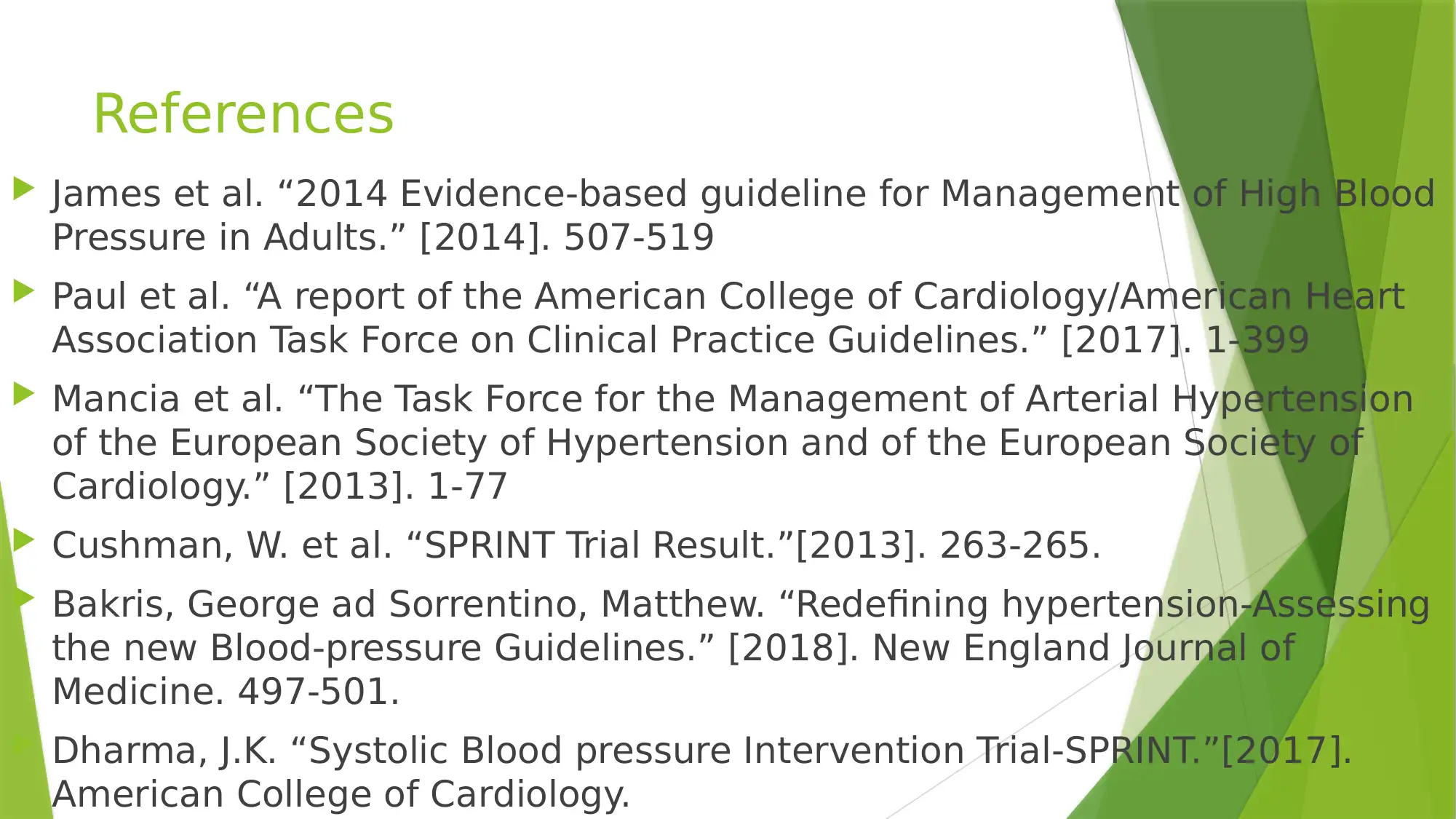
References
James et al. “2014 Evidence-based guideline for Management of High Blood
Pressure in Adults.” [2014]. 507-519
Paul et al. “A report of the American College of Cardiology/American Heart
Association Task Force on Clinical Practice Guidelines.” [2017]. 1-399
Mancia et al. “The Task Force for the Management of Arterial Hypertension
of the European Society of Hypertension and of the European Society of
Cardiology.” [2013]. 1-77
Cushman, W. et al. “SPRINT Trial Result.”[2013]. 263-265.
Bakris, George ad Sorrentino, Matthew. “Redefining hypertension-Assessing
the new Blood-pressure Guidelines.” [2018]. New England Journal of
Medicine. 497-501.
Dharma, J.K. “Systolic Blood pressure Intervention Trial-SPRINT.”[2017].
American College of Cardiology.
James et al. “2014 Evidence-based guideline for Management of High Blood
Pressure in Adults.” [2014]. 507-519
Paul et al. “A report of the American College of Cardiology/American Heart
Association Task Force on Clinical Practice Guidelines.” [2017]. 1-399
Mancia et al. “The Task Force for the Management of Arterial Hypertension
of the European Society of Hypertension and of the European Society of
Cardiology.” [2013]. 1-77
Cushman, W. et al. “SPRINT Trial Result.”[2013]. 263-265.
Bakris, George ad Sorrentino, Matthew. “Redefining hypertension-Assessing
the new Blood-pressure Guidelines.” [2018]. New England Journal of
Medicine. 497-501.
Dharma, J.K. “Systolic Blood pressure Intervention Trial-SPRINT.”[2017].
American College of Cardiology.
⊘ This is a preview!⊘
Do you want full access?
Subscribe today to unlock all pages.

Trusted by 1+ million students worldwide
1 out of 12
Your All-in-One AI-Powered Toolkit for Academic Success.
+13062052269
info@desklib.com
Available 24*7 on WhatsApp / Email
![[object Object]](/_next/static/media/star-bottom.7253800d.svg)
Unlock your academic potential
Copyright © 2020–2025 A2Z Services. All Rights Reserved. Developed and managed by ZUCOL.